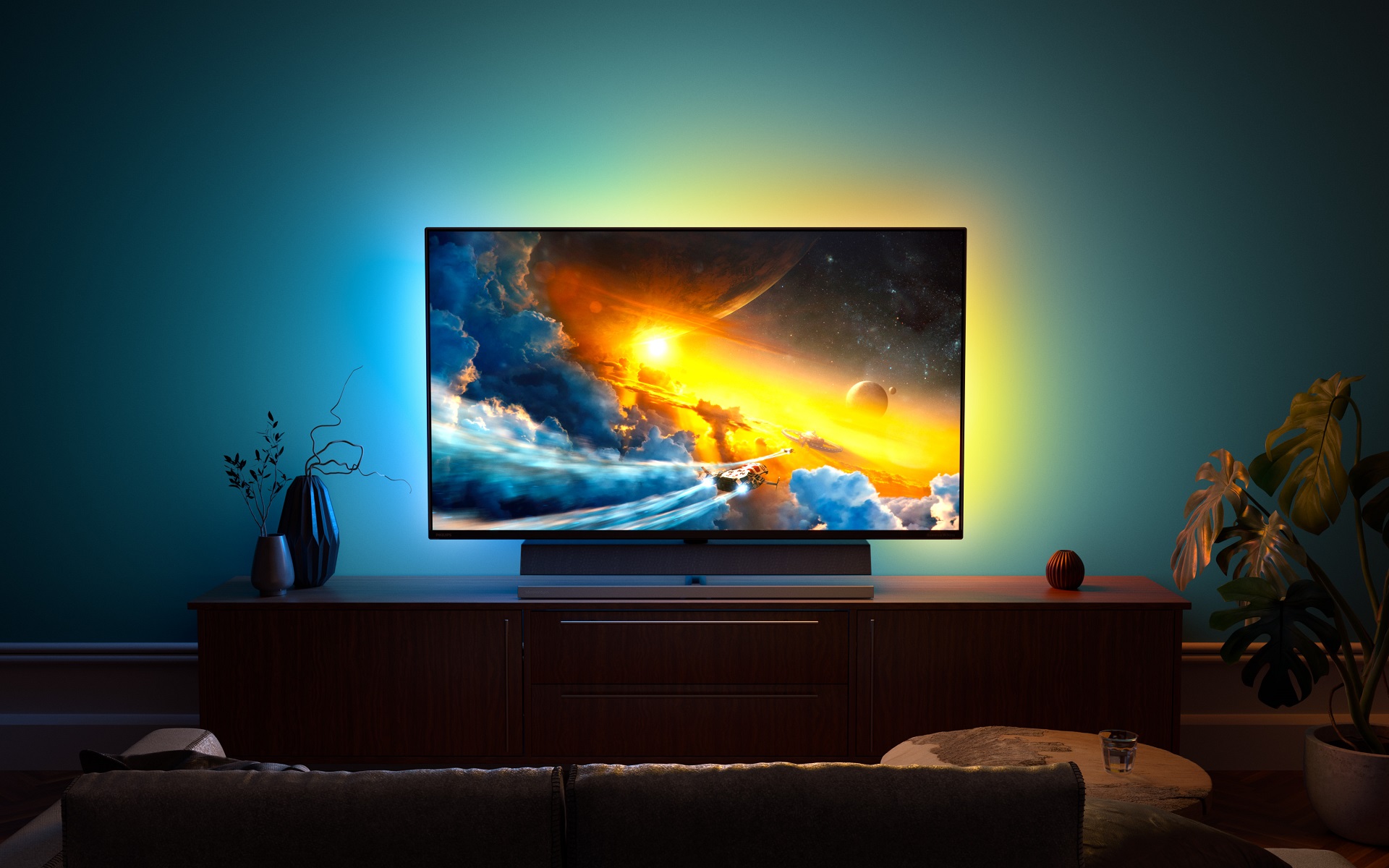Console gaming never looked so good
- Manufacturer: Philips
- Model: Momentum 558M1RY/00
- Type: Console Gaming Monitor
- Release date: 3rd September 2020
- Price when reviewed: £1199.99 (MSRP)
- Supplied by: Manufacturer
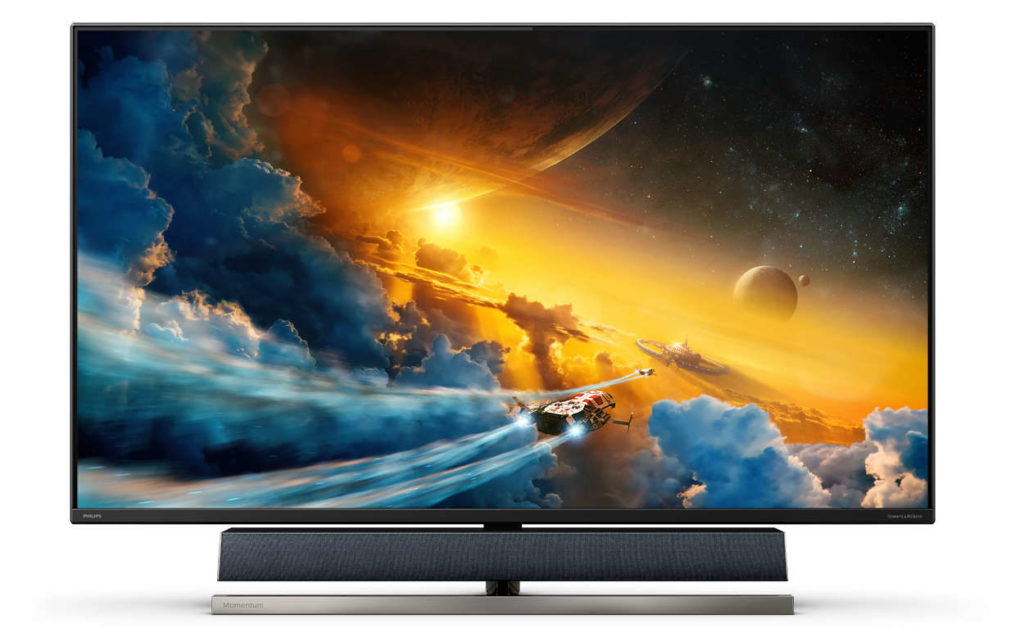
BFGD
If you’re not familiar with this term, it stands for Big Format Gaming Display (I reckon whoever coined that phrase knew exactly what they were doing – that F is meant to be the same word as in Doom’s BFG for sure!)
There’s no shortage of TV’s in the >42” category, but gaming displays have only recently started appearing in these more substantial sizes. Anyone who has used a monitor for console gaming knows why you would choose one over a TV, but for the uninitiated, it’s because monitors often offer several distinct advantages over television sets when it comes to latency, frame rates and variable refresh – key features when it comes to gaming.
The Philips Momentum 558M1RY is designed specifically for console gamers. It does a superb job with PC’s, too, but its primary focus is console gaming. A monitor of this size is ideal, especially with the next-gen nearly upon us and 4k HDR gaming set to take the forefront. Console gamers traditionally enjoy playing on a couch, sitting a little back from the screen, and for that, you need a decent size display.
(In the spirit of thorough testing, I also used this monitor for a while on my desk, in place of my usual 27” display, which is quite an experience: More on that later!)
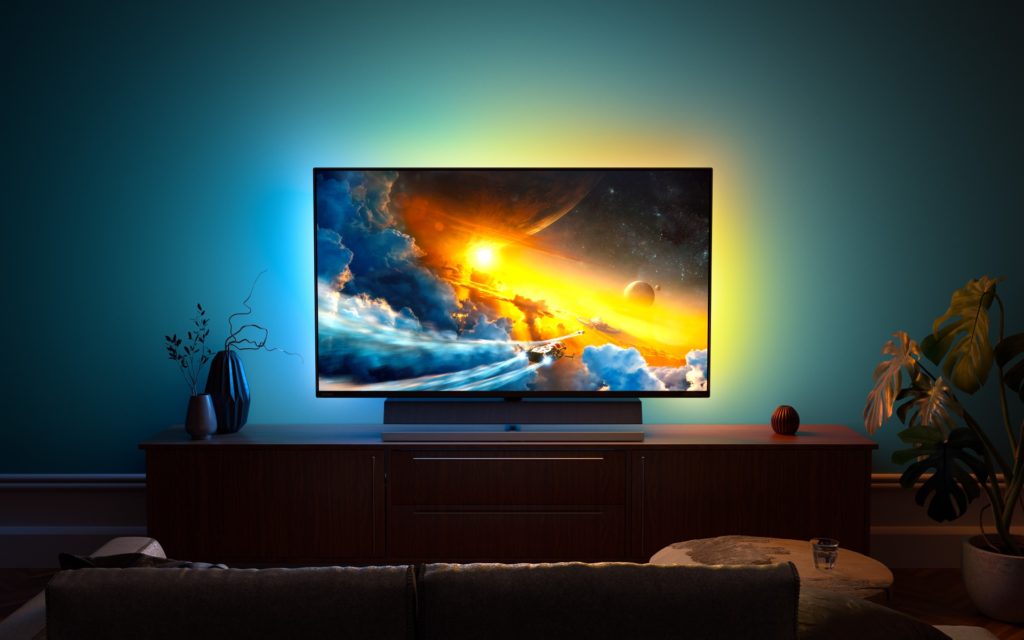
Unboxing and accessories
Big-screen displays come in big boxes. Considering this is a 55” panel, as you can imagine it comes in a BFB (let’s pretend I meant Big Format Box). As far as boxes go, though, it’s really well presented, with bold glossy imagery covering all sides. Unboxing is straightforward; cutting open the top reveals all the accessories, with the box then unclipping and lifting up and over the screen inside. I appreciate when things have been thoughtfully engineered, and when they go to such lengths to get the packaging right it makes me much more confident the product inside is going to be good too.
Once you’ve got it out of the box and removed the foam packaging and protective layers, you’ll need help to get the display where you want it. It’s a reasonable 26.5 Kg, so not beyond what a strong person can lift, but it’s difficult to manoeuvre because of the soundbar under the panel obstructing regular lifting points. I can’t stress enough that a helping hand is highly recommended if not essential.
Inside the box are Euro and UK power cables, an HDMI cable, DP cable, and the instruction manual and quick start guide.
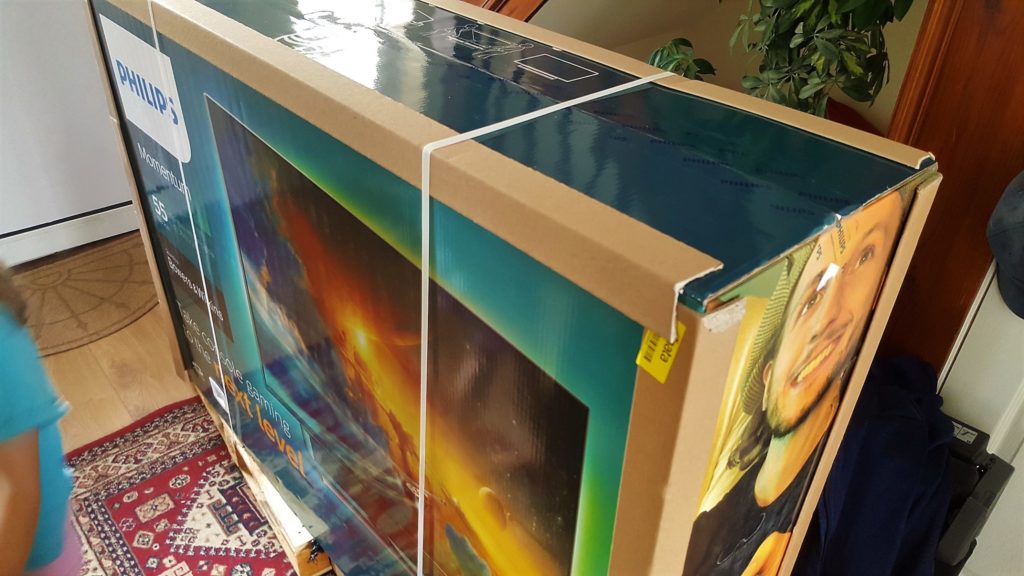
Design and build
Philips’ pedigree with televisions has shone through with the design of the Momentum 558M1RY. The narrow bezels of the display are surrounded by a gunmetal-grey metal frame. Underneath the display is the soundbar, with only the front of the T-shaped stand visible, also in the same gunmetal grey as the frame. The appearance is discrete but very stylish. For such a large screen, the side profile is quite narrow, but the display is very stable. AmbiGlow is included on this display, too, and it basks the outside of the screen in a bright glow, accentuating the action on the screen.
The screen can tilt -5/10 degrees, but there is no pivot or swivel adjustment. That’s not unsurprising for a screen of this size, and you are most likely to set it where you want it to be and leave it there anyway. If you do need flexibility, there is a VESA 200 mounting point on the rear.
The integrated soundbar is covered in a specially fabricated, acoustically transparent wool-blend material, designed by Kvadrat to not impede the sound. It’s certainly effective, but it also looks very nice, too. Philips have attached the soundbar to the base of the display and not the stand so that if you have the display tilted, the soundbar tilts as well. This is a very clever idea, as it not only allows you to have correct forward-facing audio, it also means attaching the display to a VESA mount is straightforward.
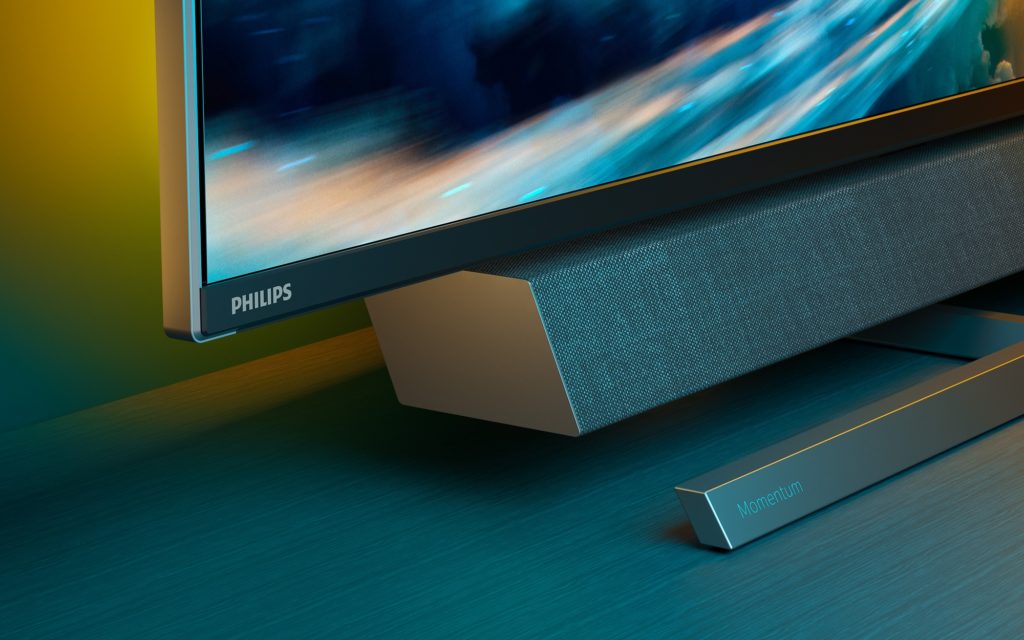
The rear of the display has a glossy wedge-shaped central panel flanking the surrounding matte-black panels. All of the ports are downward-facing, with the power cable connecting on the right of the display as you look at it, and the USB, HDMI and DisplayPort connectors on the left. There isn’t any integrated cable management system, but if you have it mounted on the stand, the cables are all concealed behind the soundbar anyway so it’s not a concern. If you choose to mount this display, it should be simple enough to run the cables through some ducting if needed.
Across the top and sides of the rear panels are the banks of LEDs for the AmbiGlow lighting. As mentioned, they are extremely bright (although maximum luminosity can be adjusted in the settings). Once you’ve experienced AmbiGlow, you’ll wonder why everyone doesn’t do something similar. It’s such a simple concept but it accentuates games and movies remarkably well. Each LED reacts to the image individually, creating a great looking surround that perfectly complements whatever is being shown on-screen. There is a slight delay to AmbiGlow reacting to changes on the screen, but it’s not distracting. Subtle changes in colour did cause the occasional flickering, but again, it’s not a real issue.


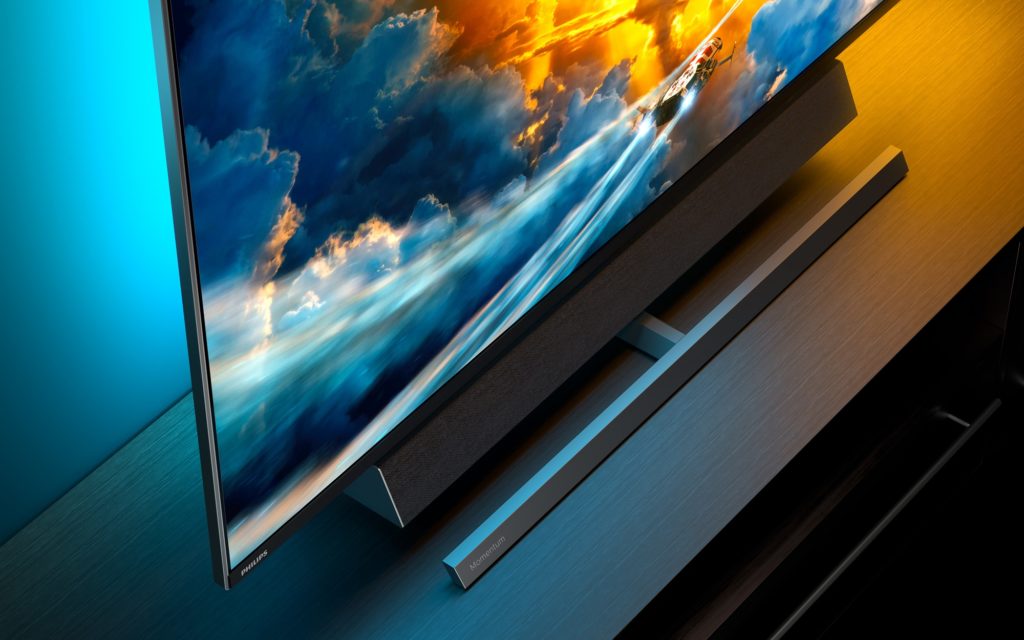
Display Quality
There is much discussion over what size screen is needed before the increased resolution of 4k (UHD) makes a difference. For me, a 27” display at arms reach is the minimum, but for a 32” screen a sofa away, not so much. The gargantuan 55” screen of the Momentum 558M1RY, however, definitely benefits from this increased resolution. Sitting just a couple of feet away the image is sharp and detailed. Sitting further back on my sofa, it’s flawless.
The Momentum comes factory calibrated using the Smart Uniformity preset, which we enabled during our testing. Panel uniformity is very good on the display we received, with almost no deviation in colour visible to the naked eye across a flat colour image displayed on-screen. Colour temperature out of the box was close to the ideal 6500K, with just a slight hint of green showing through which was easily corrected within the settings. sRGB performance is excellent, with a superb average Delta E of just 0.71. The Momentum also covers 125% of the sRGB range, 104% NTSC and 95% DCI-P3.
Brightness uniformity is equally good, with the majority of the screen maintaining a deviation of just a couple of percent, with the very bottom left and right dipping to 96% and 95% respectively. To the naked eye, this is almost imperceptible.
The factory calibration is excellent, and you shouldn’t need to make anything but the most minor adjustments to achieve accurate results. For those who just want to plug it in and play, the screen is well-enough calibrated that you shouldn’t need to change anything to fully enjoy it.
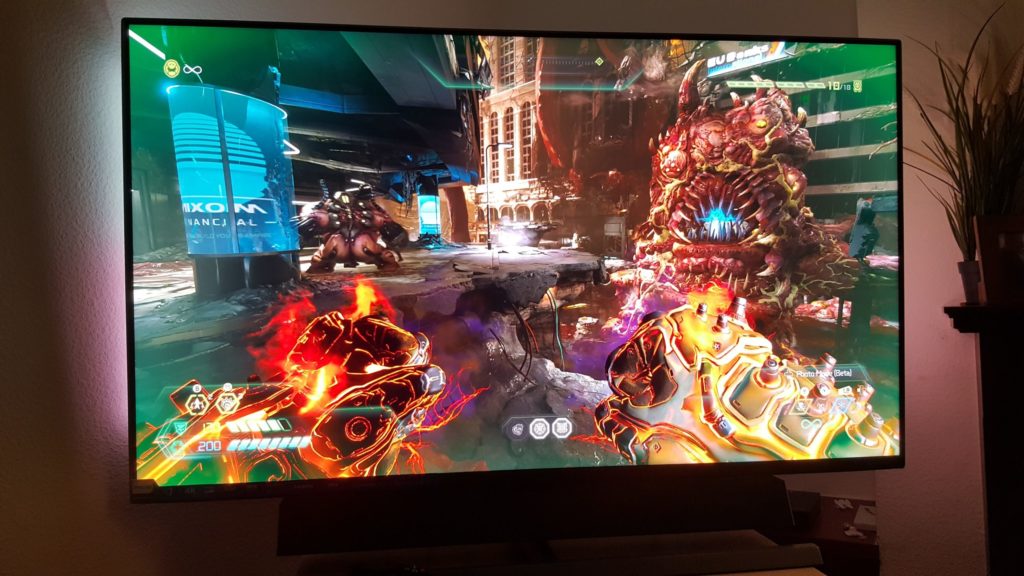
HDR performance
One of the biggest draws of this display is the HDR1000 certification. Properly implemented HDR makes far more of a difference to picture quality than pixel count. You’ll be happy to know that the Momentum excels at delivering its HDR images, as well as producing a stunning SDR picture, too.
Peak brightness for HDR content is an excellent 1200 cd/m2, while SDR content is displayed at 750 cd/m2. Combined with the excellent native contrast and black levels provided by the VA display, no matter what you play or watch on it, it’s an absolute visual feast. I found myself revisiting games I finished long ago just to experience them with the Momentum 558M1RY.
As stated, HDR performance on the Momentum is brilliant, but it’s further improved by FreeSync Premium Pro, which allows low latency HDR gaming (many panels’ response rates suffer when HDR is enabled). I tried loads of games with HDR enabled, from grand cinematic adventures like Red Dead Redemption 2 and Shadow of the Tomb Raider, to fast-paced action and shooter titles like Gears 5 and Doom Eternal. In every case, the movement was smooth, beautifully contrasted, and I detected no significant artefacts manifesting in the image.
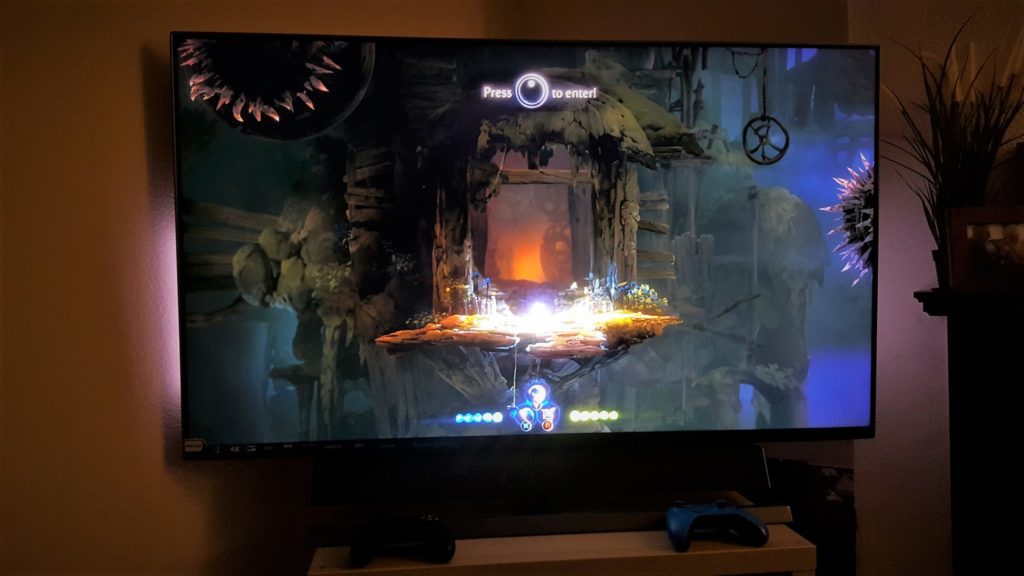
One of my personal highlights was the gorgeous Ori and the Will of the Wisps. The photo doesn’t do it justice, as our camera equipment can’t capture such a high range.
Detailing in the darker parts of the scene is rich and highly detailed, with no perceptible black-crush, and Ori is lit up incredibly brightly, contrasting sharply against the backdrop. The Momentum 558M1RY has made an already good-looking game look even better.
Within the options are a number of different HDR modes, but I found the DisplayHDR 1000 setting to provide the best balance between brightness and contrast. The game modes, in particular, interfered with the colour temperature and tended to either lower the brightness or raise the black level too much. The subpar picture was a poor tradeoff for slightly increased visibility in dark areas. It is easier to just raise the gamma in-game, which gives a better overall result.
There is a slight amount of haloing when there is a single bright element on the display surrounded by black, but it’s certainly not obtrusive. To truly achieve better results here you are going to need an OLED or at the very least a FALD display to improve on this. The brilliant brightness of the display and it’s excellent daytime/bright-lighting performance more than offsets this slight disadvantage.
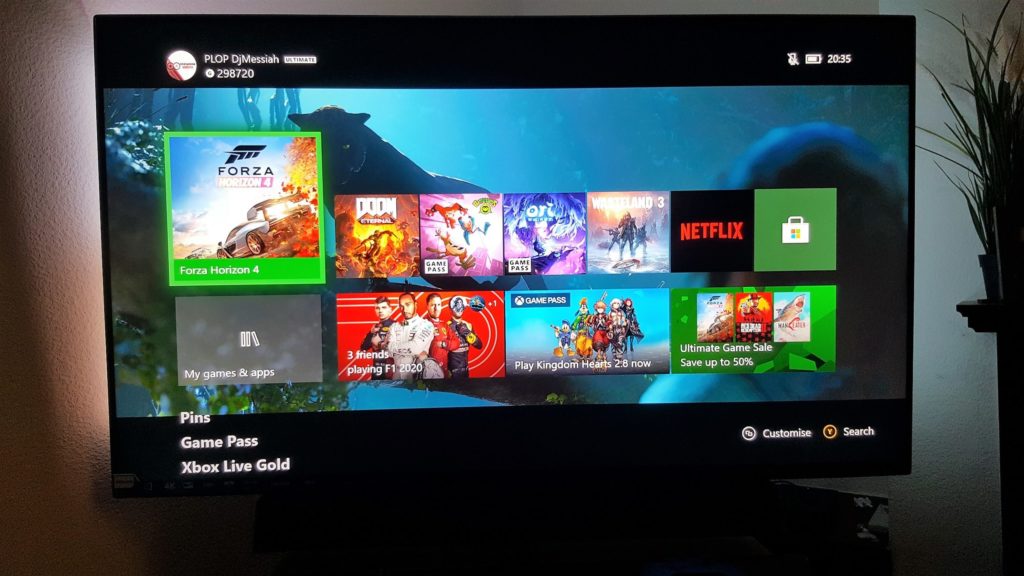
Viewing angles
Viewing angles are the weakest part of the 558M1RY’s display. Moving horizontally more than around 50° off-centre results in the colours washing out significantly. At a reasonable distance from the screen, the viewing angles you observe should be narrow enough that it’s not likely to pose too much of a problem, but I found split-screen gaming sat close introduced enough angle to negatively affect the image. This is only likely to affect a small minority of users, but it’s certainly something to be aware of, and a little disappointing when compared to the wide-angle colour stability of other displays.
It’s a similar story when you are sat above or below the display. If you’re planning on mounting this display higher-up on a wall – above a fireplace, for example – make sure you get a tilting mount so you can angle the screen downwards, as it suffers from slight desaturation of colours when viewed at less than optimal angles.
That being said, if you position yourself in the butter-zone the Momentum 558M1RY offers one of the best pictures I’ve ever seen, especially for HDR gaming.


Supported Resolutions
The Philips Momentum 558M1RY supports the following optimum resolutions:
HDMI: 3840 x 2160 @ 60 Hz, 2560 x 1440 @ 120 Hz;
DP: 3840 x 2160 @ 120 Hz
HDMI 2.1 is the new evolution of HDMI that will be supported by the next-gen consoles. HDMI 2.1 allows for the much higher data transfer rates that are necessary to enable 4k at 120Hz. It is possible to send a 4k120 signal through DisplayPort, but the Xbox Series X doesn’t have DP1.4 ports, nor do we expect the PS5 to have either. This means that if you are buying this monitor for next-gen consoles, you will be restricted to either 2160p at 60Hz or 1440p at 120Hz.
Currently, the Xbox One X and PS4 Pro support 1440p output, utilising supersampling of the original 4k (or above 1440p) source where possible. If both PS5 and Series X support actual native 1440p, this could be a good way to achieve higher frame rates if they choose to support it, but until we get more details I wouldn’t rely on this assumption.
If current PC performance has taught us anything, though, it is that 4k120Hz is incredibly challenging for the best GPUs out there, even without Ray Tracing enabled. Indeed, early next-gen launch titles are in some cases limited to just 30fps (Assassins Creed: Valhalla for one). I have no doubt some games will manage 4k120, but I expect this to be the exception rather than the norm.
With this in mind, most games will be targeting 4k60 and of course, HDR, which this monitor displays exceptionally well. If 1440p120 is properly supported, this display could actually turn out to be pretty future-proof after all, even without HDMI 2.1.
If you absolutely have to have HDMI 2.1 and 4k120Hz, Philips have informed us that they are working on monitors that support the new standard, but they are waiting until more devices adopt the technology and the price becomes more viable. Such is the quality of the Momentum 558M1RY, though, you certainly won’t be disappointed if you pick one up now.
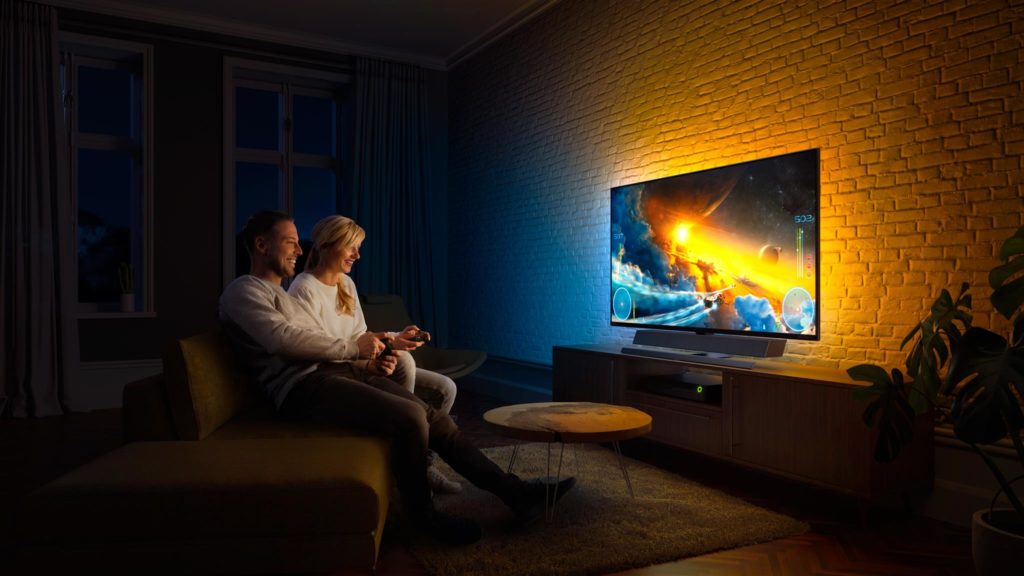
Sound Quality
If this was a normal TV or monitor, I’d probably just comment on how the sound lacks bass, and that you should just use headphones or invest in a decent soundbar or separates. This isn’t a normal screen, though. Philips have fitted the Momentum 558M1RY with an integrated Bowers & Wilkins soundbar, and it’s pretty damn good.
If you aren’t aware, Bowers & Wilkins are acclaimed British manufacturers of high-end audio devices, with a history of stunning acoustics going back to the ‘60s.
The 2.1 channel DTS soundbar comprises two tweeters, two 10 W mid-high speakers and a 20 W woofer, for a total output of 40 W (RMS). It may not sound like a lot, but the audio they produce is remarkable and more than adequate for most living rooms. Bass is punchy and full, whilst the mid to high ranges are clean, performing well even at low volumes. I’d have liked to see some way of connecting an external sub, but the integrated woofer does such a good job that for most people it won’t even be a consideration.
Because of the width of the display, the soundbar has plenty of room to spread out the speakers, and this has resulted in an impressive soundstage, with great width and stereo separation. When so many monitors and even TVs have such poor performing integrated speakers, the Bowers & Wilkins soundbar is a very welcome addition.
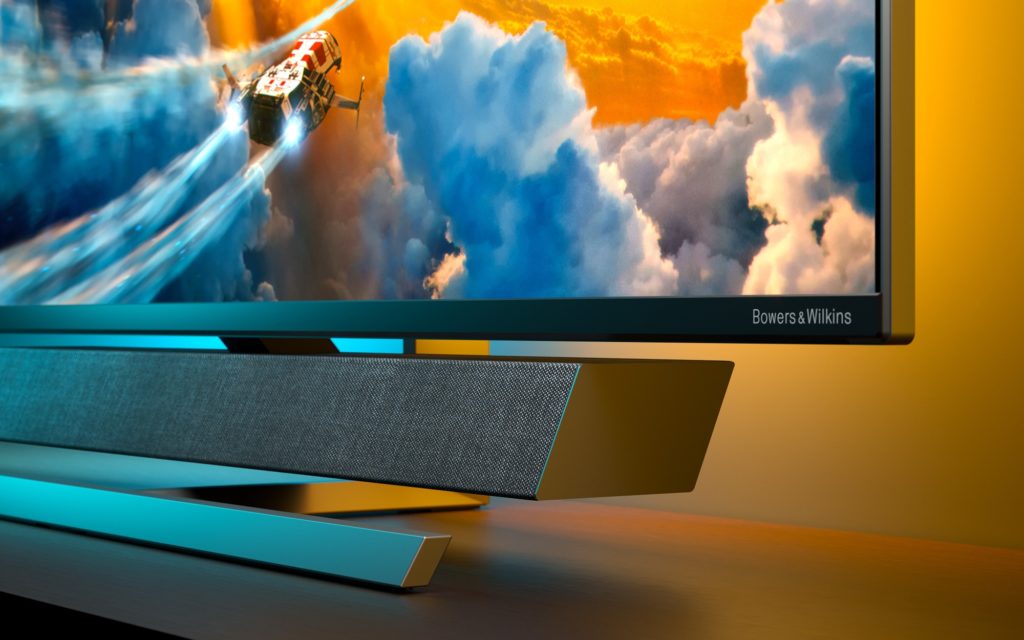
Connectivity
There’s a comprehensive lineup of ports on the 558M1RY. 1 x 3.5mm headphone output, 3 x HDMI 2.0, 1 x DisplayPort 1.4. 1 USB-B upstream (to connect to your PC), and 4 x USB 3.2 downstream ports for connecting peripherals (including two fast charge B.C 1.2). There’s more than enough here to satisfy most users’ needs, with space for multiple consoles, a cable or satellite box and even a DP equipped PC, too.
The display is basically a giant monitor, so there is no integrated TV tuner (Freeview or Freesat in the UK), but it’s perfectly possible to plug in the HDMI from most popular cable and satellite providers’ set-top boxes. The same goes for Blu-Ray players or any other HDMI equipped devices. As long as you aren’t reliant on integrated TV services or apps (which most consoles handle very well anyway), the Momentum works well as a replacement for your main screen.
My main console (Xbox One X) serves as the all-in-one media device that Microsoft intended, and we watch all our digital content, Blu-Ray discs and catch-up TV on it. Now that Xbox has started introducing HDR calibration, Netflix and Amazon Prime Video HDR works properly, and the picture quality is breathtakingly good. The Momentum 558M1RY is a great replacement for our TV, and if anything, it’s much better than a TV. You get superior gaming performance, as well as excellent SDR picture quality and HDR10+ support.

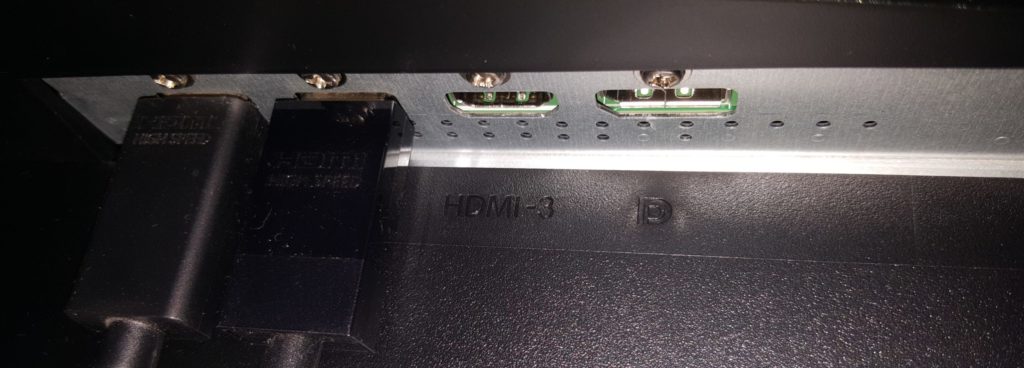
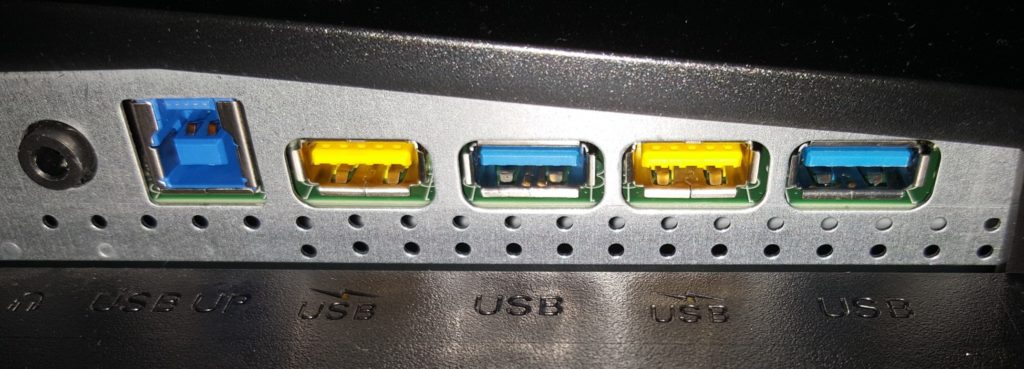
When one screen isn’t enough
The Philips Momentum 558M1RY has multiple source PIP/PBP modes (MultiView) that provide useful functionality.
PIP (picture in picture) displays an additional source in the corner of your screen. You can choose the size and location, and also which extra input is displayed there. Once that’s set up, you can then decide which of the sources you want the sound to come from. I used it to watch Netflix as I was doing a bit of in-game grinding for loot, and it works flawlessly.


PBP (picture by picture) splits the screen down the middle, displaying two correct aspect ratio 16:9 images, or in the case of PC inputs, up to 1920×2160 images. It’s excellent for multitasking or if different family members want to watch or play different things. As with PIP mode, only one audio source can be chosen as the primary, but it’s not a problem that a decent pair of headphones can’t solve. In practical use, with two consoles connected, my kids were able to both play games at the same time, saving the argument of whose turn it was next. Hallelujah!


Because I’m paid to nitpick…
For the most part, the Philips Momentum 558M1RY is flawless. There are a couple of minor annoyances, though.
The included remote is small but has quick access to all of the features you’re likely to adjust most often, and full access to the comprehensive settings and adjustments menus. The only problem is, it’s just not that responsive. I thought it may have been the UI of the monitor itself that was slow, but when using the joystick on the lower-rear of the panel, it’s snappy and reacts immediately. This is especially noticeable when moving settings up or down in large increments. For a display that’s primarily going to be replacing a standard television for a lot of people, I think a little more work could have gone into optimising the remote.
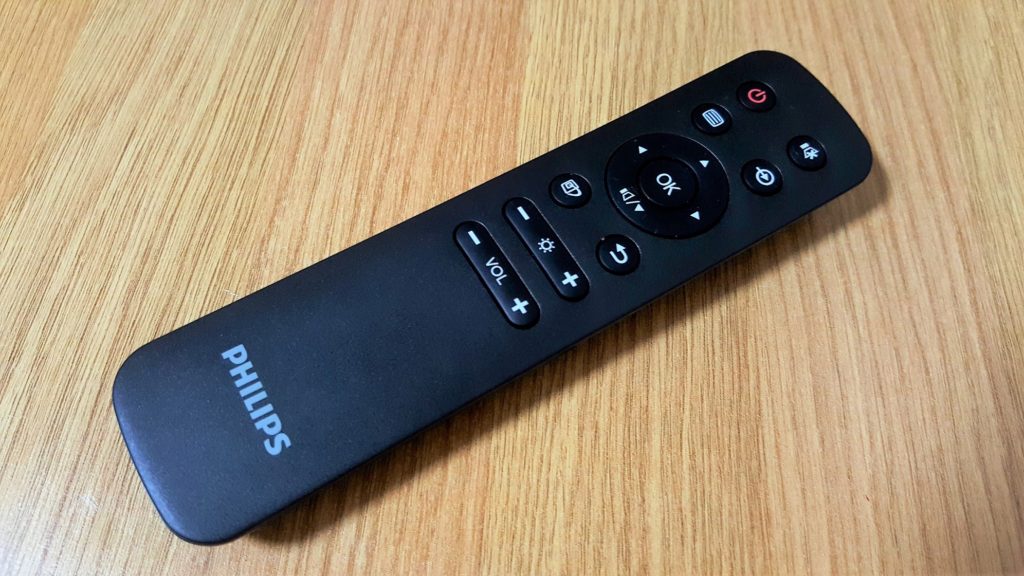
The other hindrance is the delay in changing between sources, and when switching from HDR to SDR content. It takes a good few seconds to switch sources and similar times when going from HDR to SDR (or vice versa). This in itself isn’t too bad, but it occasionally behaved like it had lost the signal, returning to standby mode or deciding to switch the source when going from HDR to SDR, such as when returning to the Xbox dashboard when playing an HDR game. It’s straightforward to just reselect the correct input with the remote, but it’s certainly a slight inconvenience.
Slightly more annoyingly, on PC, when switching to HDR the delay would cause it to switch source, and when I manually chose the right source, the colours were messed up. The only reliable workaround I found was to have something already in HDR on another source and switch directly to the PC already in HDR mode. In all fairness, I haven’t found a single monitor that plays nicely with Windows 10 HDR, so either every manufacturer has got it wrong or Windows HDR sucks. It doesn’t take a genius to work out who the real culprit is here.
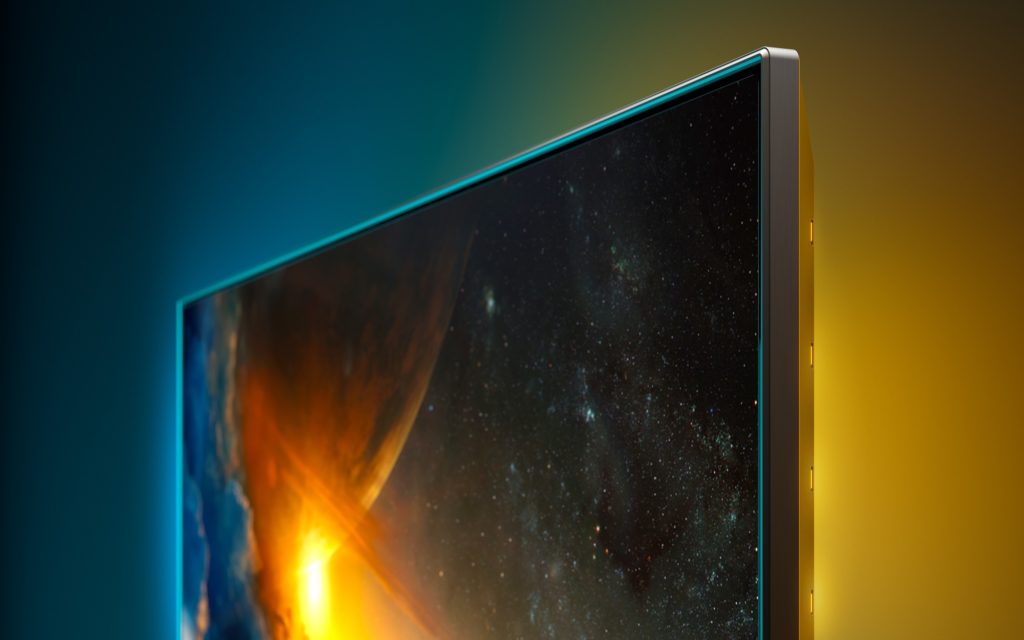
Using the 558M1RY as a desktop monitor
Let’s face it, using a 55” monitor on a desk you designed to fit a couple of laptops, consoles and a 27” monitor is, quite frankly, ludicrous, but I wanted to try it. As it turns out, it has a lot of advantages. My usual setup consists of my two laptops, and a 27” monitor, with an Xbox One X and gaming laptop sharing the inputs. The Momentum 558M1RY has enough ports to fit all my devices and then some, and in use, it was far easier to get on with than you’d expect of a humongous panel, inches from your head.
It’s basically four times the size of my usual monitor, but I found by positioning myself off to the right of the display, I could use the bottom right corner as a 27” 1080p display. This meant I had three more equivalent sized portions of screens for opening additional web pages, watching videos, editing photos, and opening large folders of documents and images that I use in articles. It was basically like having an ultrawide, ultra-tall display two feet away from me.
Using the USB passthrough, I could connect my keyboard, mouse, headset, phone or even an external HDD thanks to the high-speed USB ports. Running PIP, I could have the Xbox running with whichever game I was reviewing open in the corner of the screen (or vice versa), and it was absolutely brilliant.


The only downside was that being that close meant the limited viewing angles came into play, even relatively central to the screen. This could easily be mostly if not entirely resolved if I extended my desk out another foot or two, but it was hard enough moving my whole setup around to accommodate the behemoth display as it was. This will only be of concern if you have a shallow desk, of course.
When it was game time, I just switched it to full screen, rolled my gaming chair back a few feet, and off I went. Ludicrous? Maybe. Do I want a permanent 55” monitor on my desk? Oh yes.
I’m going to need a bigger desk…
Pricing
The Philips Momentum 558M1RY retails for just £1,199.99 MSRP, which is very competitive for a 55” display with proper HDR. When you weigh up all of the additional and gaming-friendly features like 120Hz and low latency, as a package you’d be hard-pressed to find a better alternative. When other manufacturers charge upwards of £1200 for similarly specced 27” monitors, the 558M1RY just looks better and better.
Summary
The Philips Momentum 558M1RY is an absolute delight to use. I found myself going back through games I haven’t touched in years just to see how good they looked on this incredible display. It looks stylish, gaming is amazing thanks to the low latency, the picture is wonderfully bright and HDR performance is brilliant. Console gaming never looked so good, and thanks to the integrated soundbar, the 558M1RY sounds as good as it looks, too.
